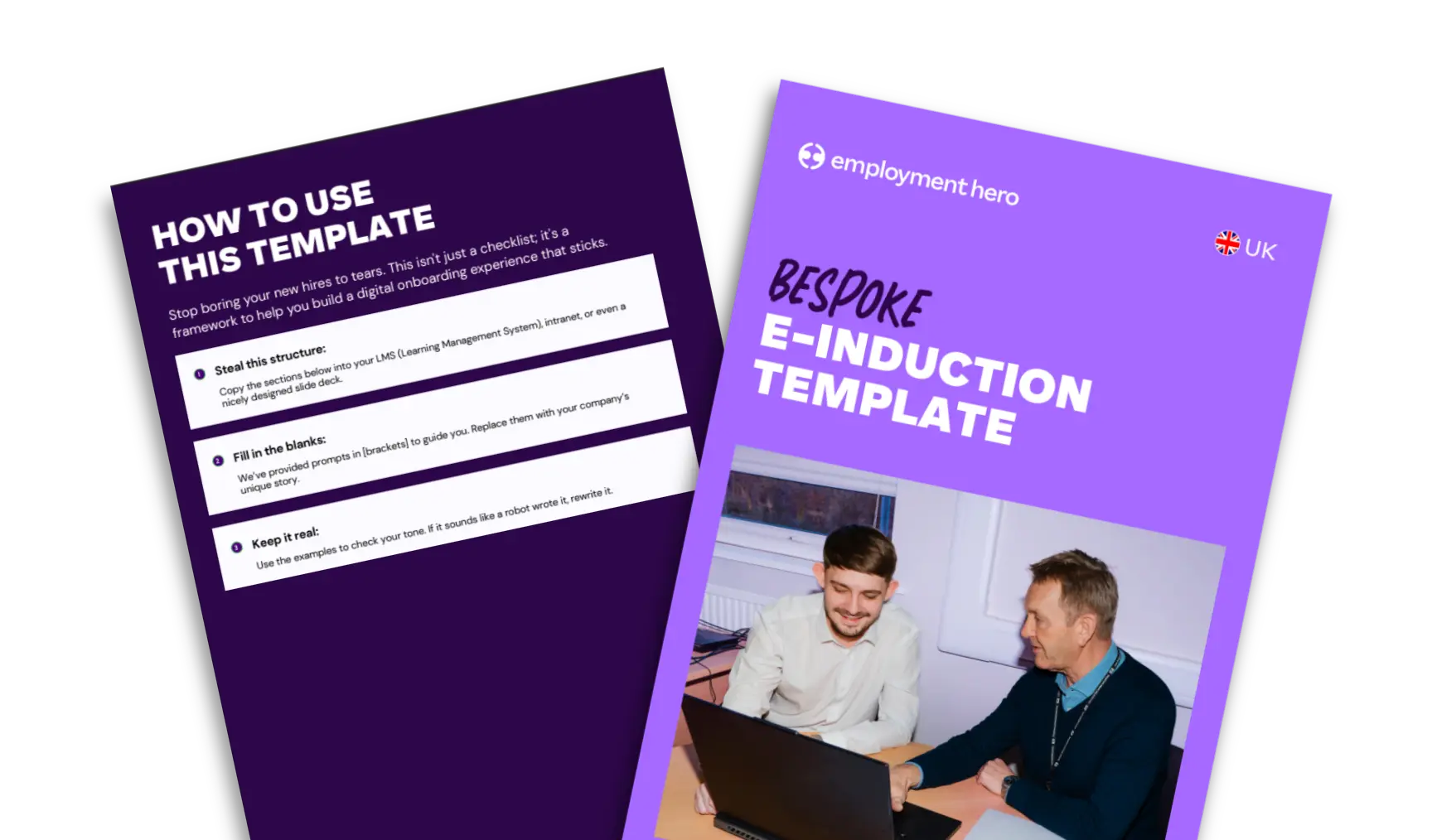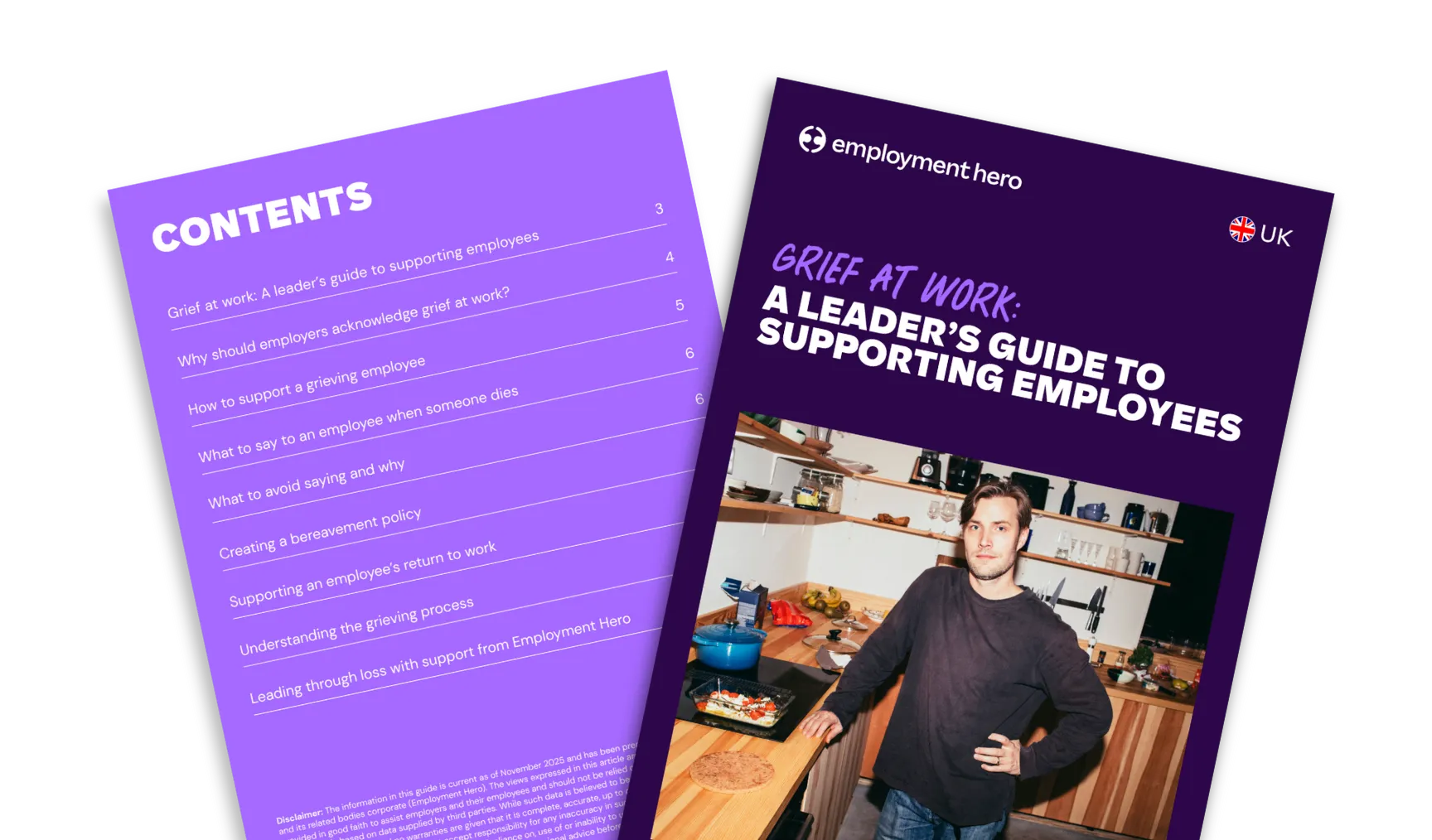Reasonable adjustments: What UK employers need to know
Published
Reasonable adjustments: What UK employers need to know
Published
Supporting employees to thrive at work means recognising that not everyone experiences the workplace in the same way. Some employees may face barriers because of a disability, long-term health conditions or neurodivergence. In these cases, UK employers have a legal duty to make what’s known as reasonable adjustments, these are changes that help level the playing field and ensure staff are not put at a disadvantage.
Understanding reasonable adjustments isn’t just about compliance with the Equality Act 2010, it’s about building a culture of inclusion and respect. By making the right changes, employers can unlock productivity, improve retention and create a workplace where everyone feels valued.
We’ll dive into what reasonable adjustments are, share practical examples and guide you through the process of putting them into practice.
What are reasonable adjustments?
Let’s start off with the basics, reasonable adjustments are changes an employer makes to remove or reduce barriers that could put an employee with a disability or long-term health condition at a disadvantage in the workplace.
Under the Equality Act 2010, employers in the UK have a legal duty to take reasonable steps to ensure that disabled employees and job applicants throughout the hiring process are not treated less favourably than others. A disability, in this context, is defined as a physical or mental impairment that has a substantial and long-term negative effect on someone’s ability to carry out normal day-to-day activities.
Core employer obligations
Employers must:
- Identify barriers: Consider how workplace practices, policies or environments may disadvantage disabled employees.
- Consult with the employee: Discuss what adjustments would be most effective and practical.
- Take reasonable action: Implement adjustments promptly, as long as they are proportionate and practical for the business.
- Review regularly: Ensure that adjustments remain effective and adapt them if the employee’s needs change.
Examples of reasonable adjustments at work
Reasonable adjustments can look different depending on the employee’s needs and the nature of the role. The goal is to remove or reduce barriers so that individuals can perform their job effectively and on equal terms with colleagues. Below are some common examples across different areas of the workplace:
Physical environment
- Installing ramps, lifts or automatic doors to improve accessibility.
- Providing adjustable desks, ergonomic chairs or specialist seating.
- Improving lighting or reducing noise levels to support sensory needs.
Working patterns
- Offering flexible start and finish times.
- Allowing part-time hours or job-sharing arrangements.
- Providing options for remote or hybrid working.
Equipment and technology
- Supplying assistive technology, such as screen readers, voice-recognition software or adapted keyboards.
- Providing hearing loops or captioning tools for meetings.
- Ensuring digital platforms are accessible (e.g. compatible with accessibility tools).
Policies and procedures
- Allowing additional breaks during the day.
- Adjusting performance targets to reflect health-related needs.
- Making absence management policies more flexible to account for medical appointments or treatment.
Do employees need a diagnosis to request adjustments?
A common misconception among employers is that staff must have a formal diagnosis before they can request reasonable adjustments. In reality, this is not the case.
Under the Equality Act 2010, what matters is whether the employee has a physical or mental impairment that has a substantial and long-term effect on their ability to carry out normal day-to-day activities, not whether they have an official medical label.
This approach recognises that many conditions – particularly mental health issues such as anxiety, depression, or neurodivergent traits – can have a significant effect on someone’s working life even if they have not (or cannot) obtain a formal diagnosis. For example, waiting times for assessments can be lengthy, and some individuals may choose not to pursue medical confirmation for personal reasons. The law is designed to ensure that these individuals are not left without support simply because of those barriers.
For employers, this means that if there is credible information suggesting that an employee is experiencing difficulties linked to a potential impairment, the duty to consider and, where reasonable, implement adjustments still applies. Taking a proactive and supportive approach in these situations not only reduces legal risk but also fosters a more inclusive workplace where employees feel safe to discuss their needs early on – often leading to better performance, retention, and morale.
Evidence requirements
While a diagnosis is not essential, employers may reasonably ask for supporting evidence to understand the employee’s needs.
This might include:
- A fit note or medical certificate from a GP.
- An occupational health report.
- A letter from a specialist or healthcare professional.
These services can help clarify how an employee’s condition impacts their work and offer practical recommendations on the types of reasonable adjustments that may be most effective. While such assessments are not a prerequisite for providing support, they can be a valuable tool in ensuring adjustments are well-informed, proportionate, and tailored to the employee’s specific needs.
Legal considerations
- Proactive duty: Employers have a duty to consider adjustments if they know or could reasonably be expected to know that an employee has a disability, even if no diagnosis has been provided.
- Confidentiality: Any medical information obtained should be handled sensitively and stored securely.
- Early intervention: Implementing adjustments promptly, even while awaiting medical advice, can prevent disadvantages and demonstrate compliance with the employment law.
Reasonable adjustments for mental health conditions
Mental health conditions, such as depression, anxiety, bipolar disorder or post-traumatic stress disorder, can have just as significant an impact on daily work as physical disabilities. Under the Equality Act 2010, these conditions may meet the definition of a disability if they are long-term and substantially affect day-to-day activities.
Employers should be proactive in making adjustments that support mental wellbeing and reduce workplace stressors. These do not always require major changes; small, thoughtful steps can make a big difference.
Examples of reasonable adjustments for mental health
- Flexible hours: Allowing later start times, shorter working days or time off for therapy and medical appointments.
- Quiet spaces: Providing access to calm, low-stimulation areas where employees can take breaks when needed.
- Temporary workload changes: Adjusting deadlines, redistributing tasks or reducing responsibilities during periods of ill health.
- Remote or hybrid working: Giving employees more control over their environment and reducing commuting stress.
- Supportive management practices: Scheduling regular one-to-one check-ins, providing clear instructions and offering structured feedback.
- Buddy or mentoring systems: Pairing employees with trusted colleagues for additional support.
Why it matters
Taking mental health seriously in the context of reasonable adjustments not only helps meet legal obligations but also improves employee engagement, reduces absenteeism and creates a more open, supportive workplace culture.
Adjustments for neurodivergent employees
Neurodiversity in the workplace is an umbrella term that includes conditions such as autism, ADHD, dyslexia and dyspraxia. Neurodivergent employees often bring unique strengths to the workplace, but they may also encounter barriers if working environments and practices are not designed with inclusivity in mind.
Employers have a duty under the Equality Act 2010 to make reasonable adjustments for neurodivergent staff where their condition meets the definition of a disability. However, even when not legally required, proactive adjustments can improve productivity, confidence and retention.
Examples of reasonable adjustments for neurodivergent employees
- Software tools: Speech-to-text applications, grammar support tools or screen readers to help with reading and writing tasks.
- Alternative communication formats: Supplementing verbal instructions with written notes, visual aids or checklists.
- Clear structures and routines: Breaking down tasks into smaller steps or providing agendas in advance of meetings.
- Mentoring or buddy systems: Pairing employees with a colleague who can provide informal guidance and support.
- Interview and recruitment adjustments: Allowing extra time for tests, providing questions in advance or offering alternative assessment methods.
- Workspace adaptations: Noise-cancelling headphones, quiet zones or permission to move around during the day.
Why adjustments matter
When neurodivergent employees are supported, they can thrive and make valuable contributions through innovation, problem-solving and attention to detail. Making reasonable adjustments isn’t just about compliance, it’s about building a diverse workforce that benefits everyone.
Process for requesting and handling adjustments
A consistent, transparent process helps employees feel supported while ensuring employers meet their legal duties under the Equality Act 2010. The process doesn’t need to be complicated, but it should be structured so requests are handled fairly and efficiently.
Step 1: Employee request
- The employee raises a need for adjustments, either formally (through HR or a request form) or informally (in conversation with their manager).
- Employers should encourage open dialogue and reassure staff that requests will be treated sensitively and without stigma.
Step 2: Assessment
- The employer discusses the request with the employee to understand specific challenges and potential solutions.
- Occupational health input or medical advice may be sought where necessary.
- The focus should be on collaboration, not interrogation—the aim is to identify barriers, not prove eligibility.
Step 3: Implementation
- Agreed adjustments are put in place as promptly as possible.
- These may involve changes to physical space, working hours, equipment or policies.
- Adjustments should be documented so that expectations are clear for both the employee and manager.
Step 4: Review
- Adjustments should not be “set and forget.” Regular reviews—ideally every few months or after significant changes—ensure they remain effective.
- Reviews provide an opportunity to adapt adjustments as the employee’s role, health or working environment evolves.
Best practice tip
Employers should create a reasonable adjustments passport or similar document. This records agreed changes and travels with the employee if they change roles or managers, ensuring continuity and reducing the need for repeated conversations.
Compliance risks of failing to make adjustments
Failing to make reasonable adjustments is not just poor practice—it can amount to unlawful discrimination under the Equality Act 2010. The consequences can be serious, exposing employers to financial, legal and reputational risks.
Discrimination claims
If an employee can show they were disadvantaged because adjustments were not made, they may bring a disability discrimination claim. Unlike unfair dismissal claims, there is no cap on compensation for discrimination, meaning awards can be significant.
Employment Tribunal outcomes
Tribunals take a strict view of employers who fail to comply with their duty to make adjustments. Outcomes may include:
- Orders to pay financial compensation.
- Mandatory changes to policies or workplace practices.
- Damage to employer–employee relationships, even if the business ultimately wins the case.
Reputational damage
Beyond legal costs, failing to act fairly and inclusively can harm an organisation’s reputation. Risks include:
- Negative press coverage from high-profile tribunal cases.
- Loss of employee trust and engagement.
- Difficulty attracting and retaining diverse talent.
Why reviewing and recording adjustments is essential
Making reasonable adjustments is not a one-off task. Employees’ needs can change over time, as can workplace environments, job roles or technology. That’s why recording and regularly reviewing adjustments is a critical part of good HR practice.
The importance of documentation
- Clarity and accountability: Recording agreed adjustments ensures both the employee and manager understand what has been put in place.
- Consistency: Documentation helps avoid misunderstandings, particularly if an employee changes roles or managers.
- Evidence of compliance: In the event of a dispute or legal challenge, having clear records demonstrates that the employer has met their duty under the Equality Act 2010.
How often should adjustments be reviewed?
- Regular reviews: At least once or twice a year or sooner if the employee requests it.
- Trigger points: Reviews should also take place when there are changes in the employee’s health, role responsibilities or workplace set-up (e.g. office move, new systems).
- Collaborative check-ins: Reviews should be a two-way conversation, focusing on whether the adjustments remain effective and whether new support is needed.
HR best practice
- Use a reasonable adjustments passport or central record that moves with the employee across roles.
- Ensure managers are trained to spot when adjustments may no longer be working.
- Treat reviews as part of an ongoing commitment to inclusion, not just a compliance exercise.
Regularly reviewing and recording adjustments shows employees that their employer is committed to long-term support, not just ticking a legal box. This builds trust, improves retention and fosters a truly inclusive culture.
How to create a reasonable adjustments policy
A well-written reasonable adjustments policy ensures consistency, transparency and fairness across your organisation. It also signals to employees and job applicants that your business takes inclusion seriously and cares about creating an environment where all employees can thrive.
What to include in the policy
- Purpose and scope: Explain why the policy exists, who it applies to and how it supports equality and inclusion.
- Definitions: Provide clear definitions of “reasonable adjustments” and “disability” under the Equality Act 2010.
- Request process: Outline how employees can request adjustments, who they should speak to and what information may be needed.
- Assessment and implementation: Detail how requests will be considered, including the role of HR, managers and occupational health.
- Review and documentation: Set expectations for recording adjustments and reviewing them regularly.
- Confidentiality: Reassure employees that any health or medical information will be treated sensitively and stored securely.
How to communicate the policy
- Onboarding and training: Introduce the policy during new starter inductions and manager training.
- Accessibility: Ensure the policy is easy to find, written in plain language and available in accessible formats.
- Regular reminders: Share updates through internal communications channels, such as newsletters or intranet posts.
Aligning with your wider D&I strategy
A reasonable adjustments policy should not sit in isolation. At Employment Hero, we believe it should form part of your wider diversity and inclusion (D&I) strategy, reinforcing commitments to equality across recruitment, development and retention. This alignment creates a joined-up approach that benefits every employee, not only those with disabilities or health conditions.
By embedding your policy into a broader D&I framework, you show that reasonable adjustments are not an afterthought, but a key part of building an inclusive workplace culture. And with Employment Hero’s HR Advisory services, you don’t have to do it alone, our team can provide expert guidance, templates and tailored advice to help you create policies that meet compliance requirements while supporting your people to do their best work.
To download the template, we just need a few quick details.
Related Resources
-
 Read more: How to Create Bespoke E-Inductions For New Hires And Contractors
Read more: How to Create Bespoke E-Inductions For New Hires And ContractorsHow to Create Bespoke E-Inductions For New Hires And Contractors
Learn how to design bespoke e-inductions for new hires and contractors. Discover flexible, learner-centred solutions to improve onboarding and retention.
-
 Read more: Power Your Accounting Firm with Employment Hero
Read more: Power Your Accounting Firm with Employment HeroPower Your Accounting Firm with Employment Hero
Join the Employment Hero Accounting Partner Programme. Earn commission, access exclusive support and help SMEs simplify HR and payroll management.
-
 Read more: Grief at work: A leader’s guide to supporting employees
Read more: Grief at work: A leader’s guide to supporting employeesGrief at work: A leader’s guide to supporting employees
Learn how to support grieving employees and create a compassionate workplace. Discover what to say, what to avoid, and how…



















